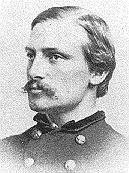
Major Edward Needles Hallowell, 1863.
MOLLUS—Mass. Collection, USAMHI.

Born on 3 November 1837 in Philadelphia, where he grew up in a Quaker family with strong abolitionist beliefs, Edward Needles Hallowell was a merchant in Medford, Massachusetts when the war began. He enlisted as a 2nd Lieutenant with the 20th Massachusetts in January 1862, and saw action in the Peninsula Campaign, and at Antietam and Fredericksburg. He was promoted to 1st Lieutenant in November 1862. Edward then transferred to the 54th Massachusetts as a Captain in March 1863. His brother Norwood was originally the lieutenant colonel of the regiment, but was soon transferred to take command of the all-black 55th Massachusetts Infantry. As a result, Edward Hallowell was promoted to major in April 1863, then lieutenant colonel in May. He assumed the position as second in command of the regiment, under Colonel Robert Shaw.
When Colonel Shaw was killed in the attack on Battery Wagner, South Carolina, on 18 July 1863, Edward Hallowell also suffered three wounds and was sent home to Massachusetts to recover. Promoted to colonel soon after, he returned to command the 54th in September 1863. After the Battle of Olustee, the 54th returned to the Charleston, South Carolina area, where it took part in the siege of Fort Fisher and Charleston. Colonel Hallowell was often in brigade command, with Lieutenant Colonel Henry Hooper assuming command of the 54th. Hallowell was promoted to Brevet Brigadier General of U.S. Volunteers in June 1865 and was discharged in August 1865, returning to civilian life. He died on 26 July 1871, probably from the effects of his wounds, in Medford, Massachusetts. (from A Brave Black Regiment)
|
Colonel Fifty-fourth Massachusetts Volunteers. |
Lieut. R. M. HALL,
Copied from The Official Records of the War of Rebellion.
External Links
Wikipedia page on Edward Needles Hallowell
Return to the 54th Massachusetts page
Other Reports from Olustee
Battle of Olustee home page
http://battleofolustee.org/